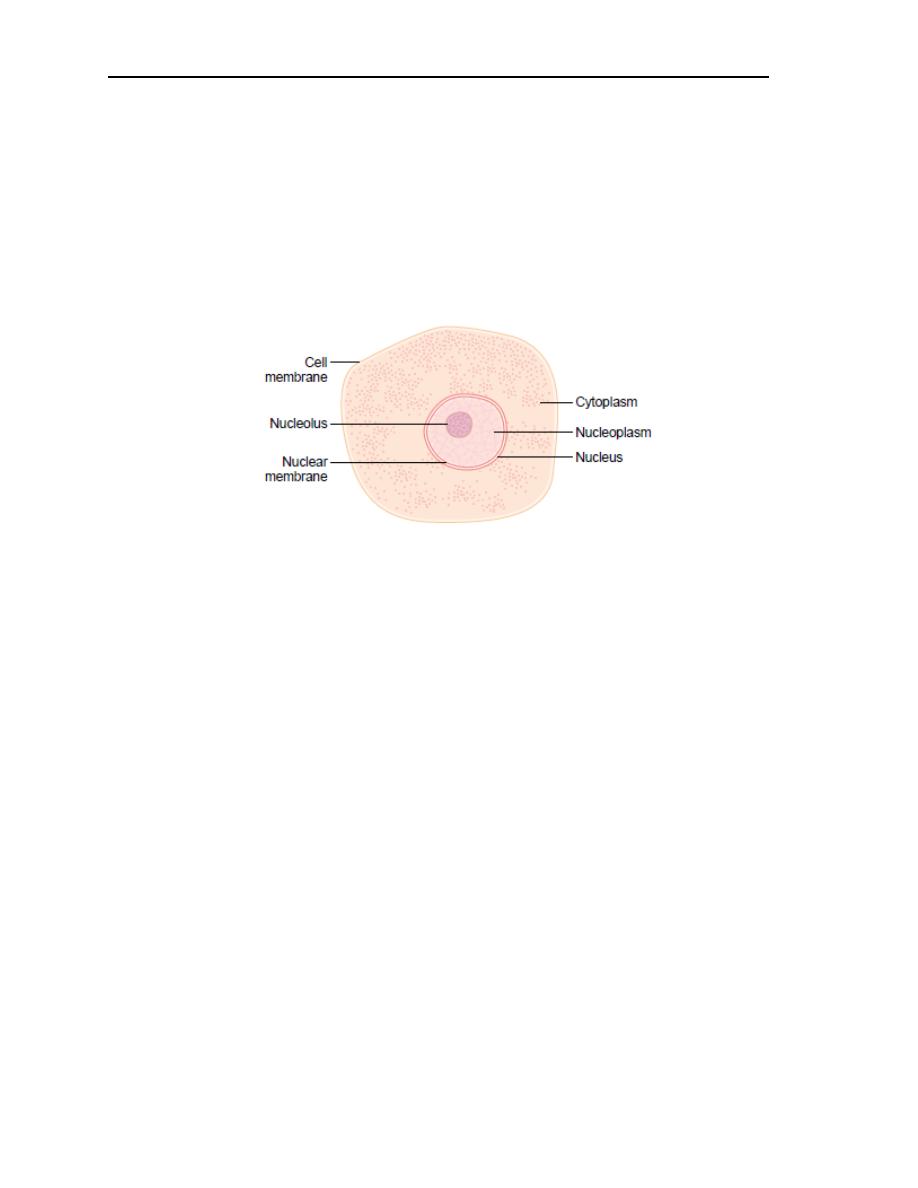
Lec. : 1 Physiology
1
The Cell and Its Functions
A typical cell, as seen by the light microscope, is shown in Figure below. Its two
major parts are the
nucleus
and the
cytoplasm.
The nucleus is separated from the
cytoplasm by a
nuclear membrane,
and the cytoplasm is separated from the
surrounding fluids by a
cell membrane,
also called the
plasma membrane.
The
different substances that make up the cell are collectively called
protoplasm.
Protoplasm is composed mainly of five basic substances: water, electrolytes,
proteins, lipids, and carbohydrates.
Physical Structure of the Cell
The cell is not merely a bag of fluid, enzymes, and chemicals; it also contains highly
organized physical structures, called intracellular organelles. The physical nature of
each organelle is as important as the cell’s chemical constituents for cell function.
For instance, without one of the organelles, the mitochondria, more than 95 percent
of the cell’s energy release from nutrients would cease immediately. The most
important organelles and other structures of the cell are shown in Figure below.
Cell Membrane
The cell membrane (also called the plasma membrane), which envelops the cell, is
a thin, pliable, elastic structure only 7.5 to 10 nanometers thick. It is composed almost
entirely of proteins and lipids.
Cytoplasm and Its Organelles
The cytoplasm is filled with both minute and large dispersed particles and
organelles. The clear fluid portion of the cytoplasm in which the particles are
dispersed is called
cytosol;
this contains mainly dissolved proteins, electrolytes, and
glucose.
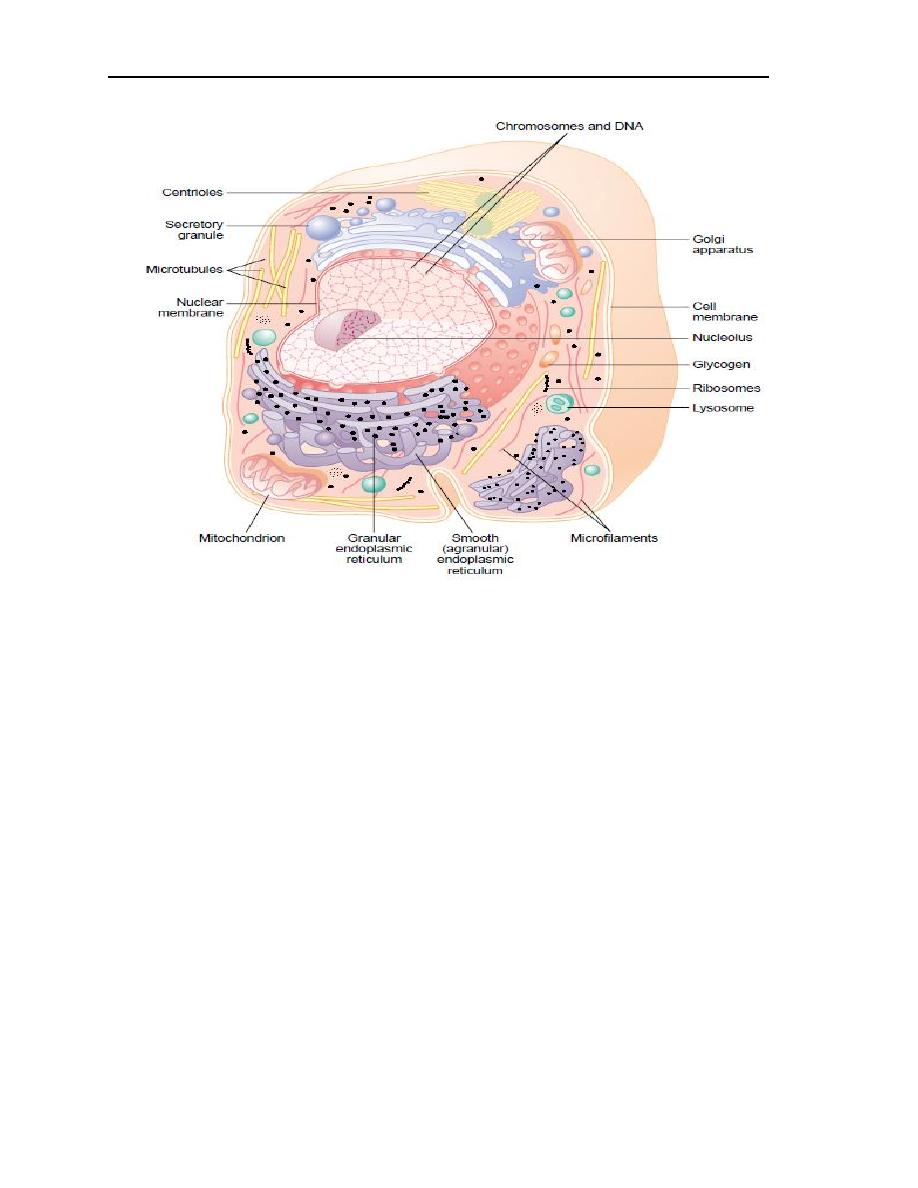
Lec. : 1 Physiology
2
1.
Endoplasmic Reticulum: A network of tubular and flat vesicular
structures in the cytoplasm
.
The tubules and vesicles interconnect with one
another. Also, their walls are constructed of lipid bilayer membranes that contain
large amounts of proteins, similar to the cell membrane.
Ribosomes and the Granular Endoplasmic Reticulum:
Attached to the outer surfaces of many parts of the endoplasmic reticulum are
large numbers of minute granular particles called
ribosomes.
Where these are
present, the reticulum is called the
granular endoplasmic reticulum.
The
ribosomes are composed of a mixture of RNA and proteins, and they function
to synthesize new protein molecules in the cell.
Agranular Endoplasmic Reticulum: Part of the endoplasmic
reticulum has no attached ribosomes. This part is called the
agranular,
or
smooth, endoplasmic reticulum.
The agranular reticulum functions for the
synthesis of lipid substances and for other processes of the cells promoted by
intrareticular enzymes.
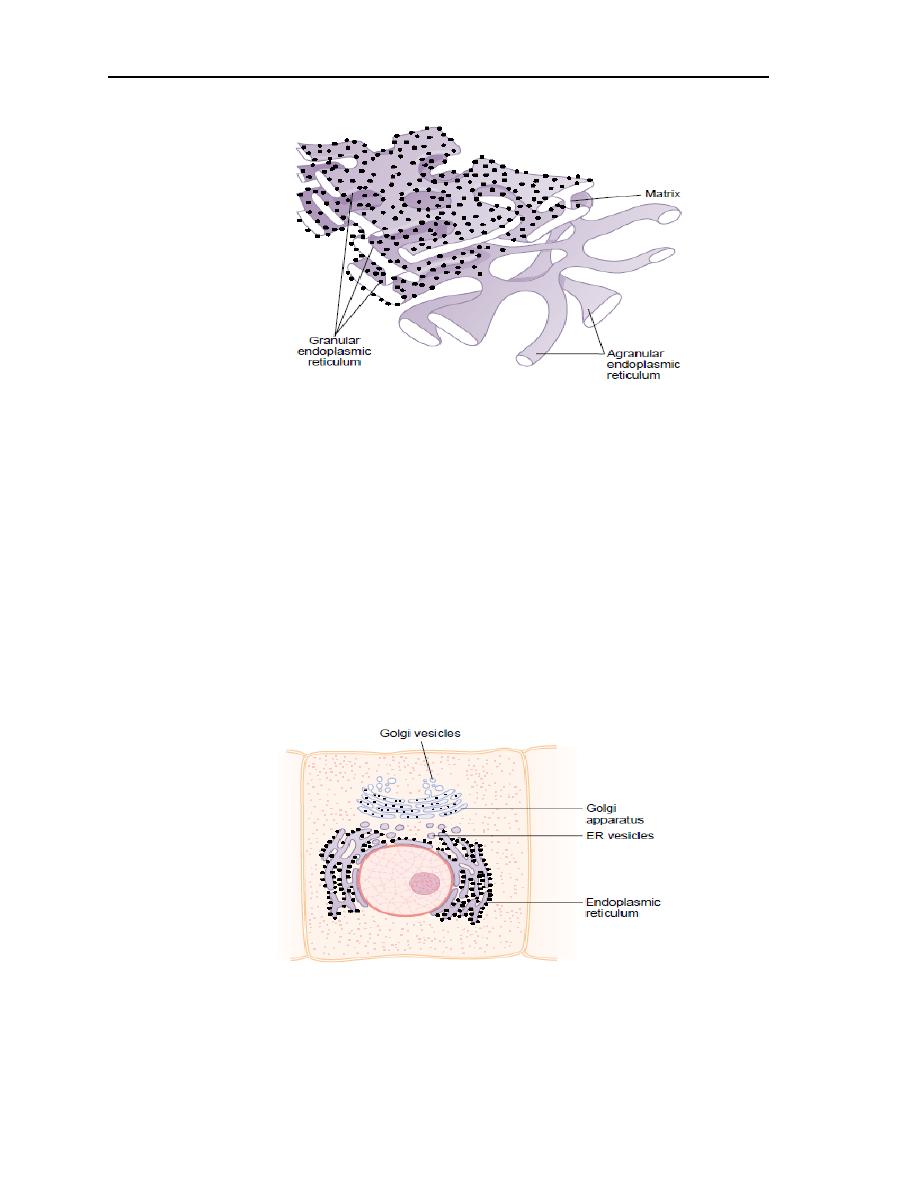
Lec. : 1 Physiology
3
2.
Golgi apparatus: is closely related to the endoplasmic reticulum. It has
membranes similar to those of the agranular endoplasmic reticulum. It usually is
composed of four or more stacked layers of thin, flat, enclosed vesicles lying near
one side of the nucleus. This apparatus is prominent in secretory cells, where it is
located on the side of the cell from which the secretory substances are extruded.
The Golgi apparatus functions in association with the endoplasmic reticulum. As
shown in Figure below, small “transport vesicles” (also called endoplasmic
reticulum vesicles, or
ER vesicles
) continually pinch off from the endoplasmic
reticulum and shortly thereafter fuse with the Golgi apparatus. In this way,
substances entrapped in the ER vesicles are transported from the endoplasmic
reticulum to the Golgi apparatus. The transported substances are then processed
in the Golgi apparatus to form lysosomes, secretory vesicles, and other
cytoplasmic components.
3. Lysosomes: are vesicular organelles that form by breaking off from the Golgi
apparatus and then dispersing throughout the cytoplasm. The lysosomes provide
an
intracellular digestive system
that allows the cell to digest (1) damaged
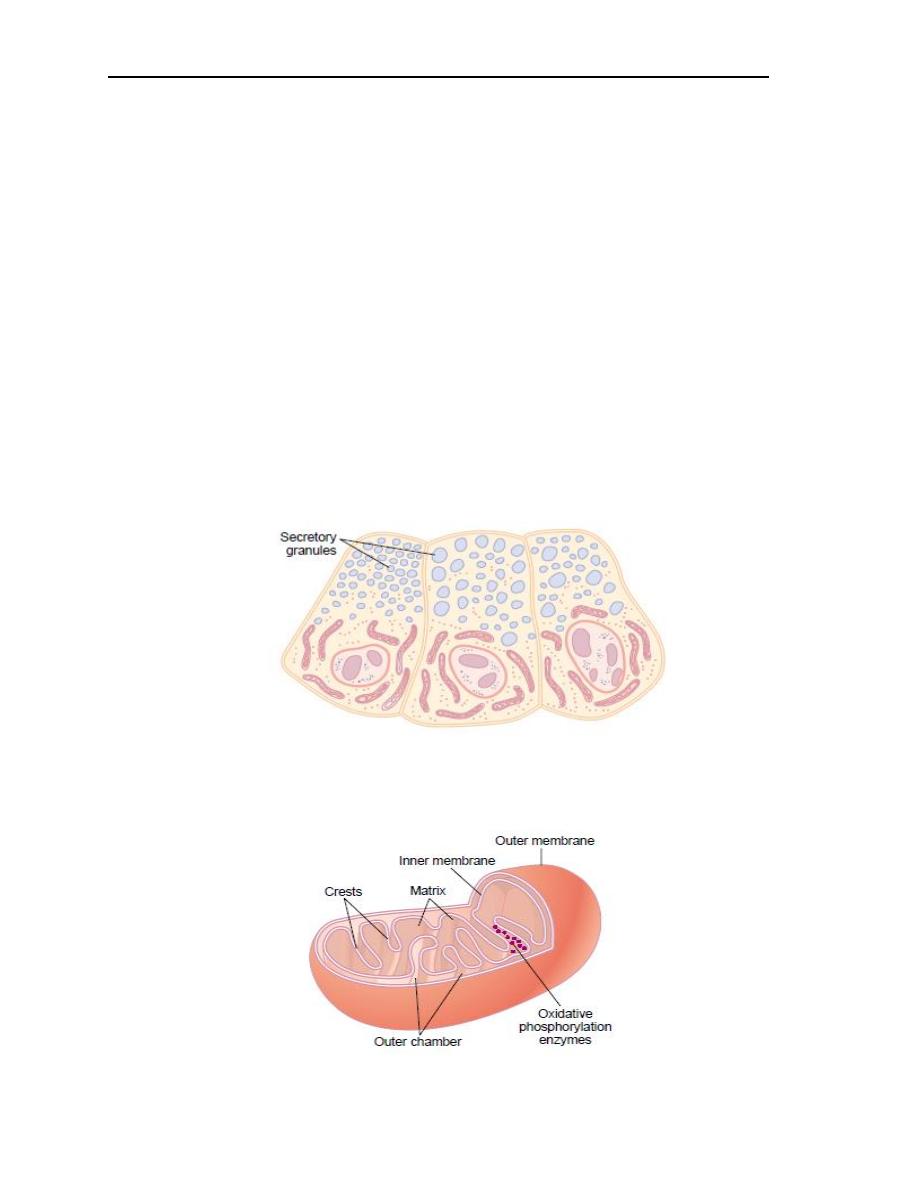
Lec. : 1 Physiology
4
cellular structures, (2) food particles that have been ingested by the cell, and (3)
unwanted matter such as bacteria.
4.
Peroxisomes: are similar physically to lysosomes, but they are different in
two important ways. First, they are believed to be formed by self-replication (or
perhaps by budding off from the smooth endoplasmic reticulum) rather than from
the Golgi apparatus. Second, they contain oxidases rather than hydrolases.
Several of the oxidases are capable of combining oxygen with hydrogen ions
derived from different intracellular chemicals to form hydrogen peroxide (H
2
O
2
).
5.
Secretory Vesicles: One of the important functions of many cells is
secretion of special chemical substances. Almost all such secretory substances
are formed by the endoplasmic reticulum–Golgi apparatus system and are then
released from the Golgi apparatus into the cytoplasm in the form of storage
vesicles called
secretory vesicles
or
secretory granules.
Figure below shows
typical secretory vesicles inside pancreatic acinar cells; these vesicles store
protein proenzymes (enzymes that are not yet activated).
6.
Mitochondria: are called the “powerhouses” of the cell. Without them, cells
would be unable to extract enough energy from the nutrients, and essentially all
cellular functions would cease.
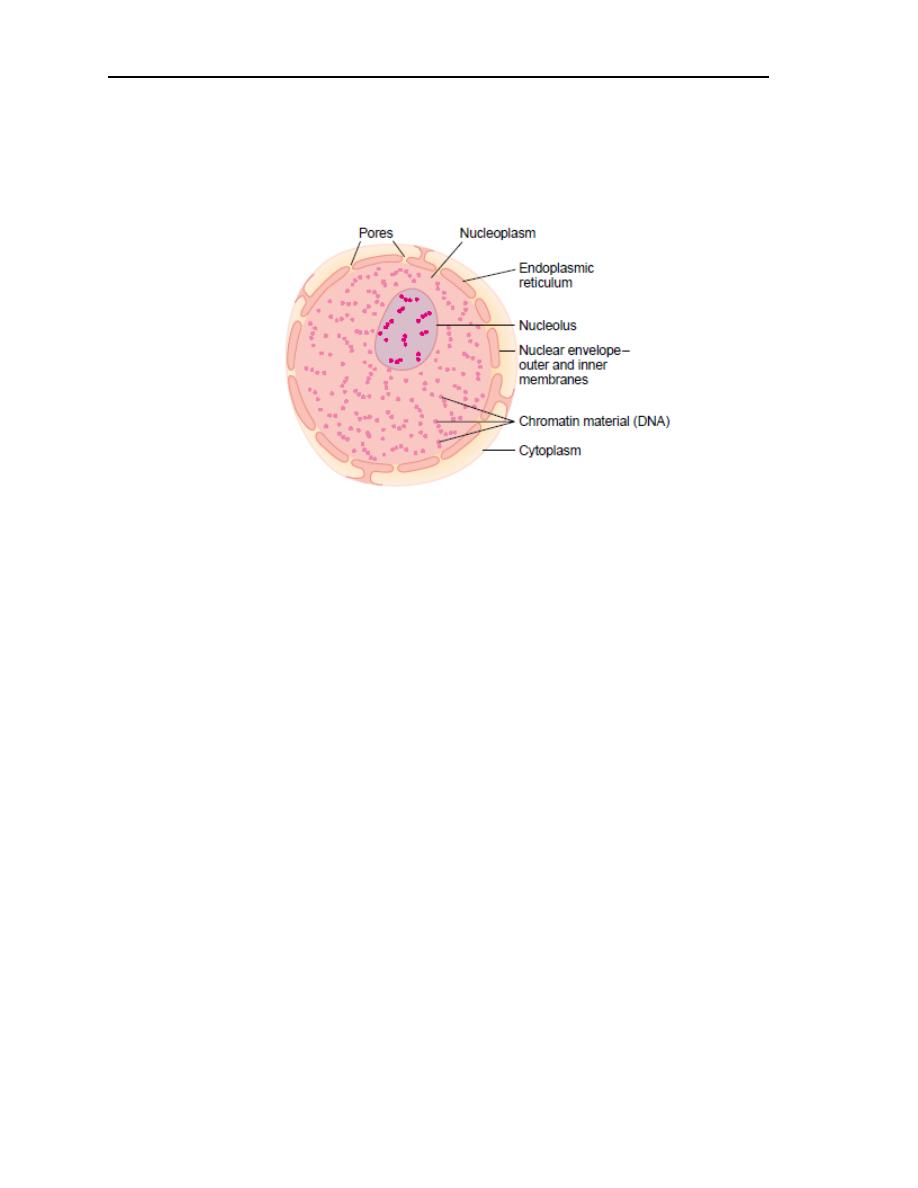
Lec. : 1 Physiology
5
7.
Nucleus: is the control center of the cell. Briefly, the nucleus contains large
quantities of DNA, which are the
genes.
The genes determine the characteristics
of the cell’s proteins, including the structural proteins, as well as the intracellular
enzymes that control cytoplasmic and nuclear activities.
Ingestion by the Cell—Endocytosis
If a cell is to live and grow and reproduce, it must obtain nutrients and other
substances from the surrounding fluids. Most substances pass through the cell
membrane by
diffusion
and
active transport.
Diffusion involves simple movement through the membrane caused by the random
motion of the molecules of the substance; substances move either through cell
membrane pores or, in the case of lipid soluble substances, through the lipid matrix
of the membrane.
Active transport involves the actual carrying of a substance through the
membrane by a physical protein structure that penetrates all the way through the
membrane.
Very large particles enter the cell by a specialized function of the cell membrane
called
endocytosis.
The principal forms of endocytosis are
pinocytosis
and
phagocytosis.
Pinocytosis means ingestion of minute particles that form vesicles of
extracellular fluid and particulate constituents inside the cell cytoplasm.
Phagocytosis means ingestion of large particles, such as bacteria, whole cells, or
portions of degenerating tissue.
